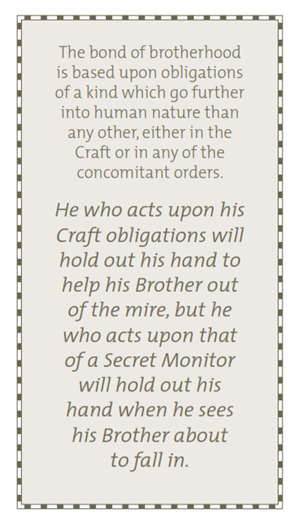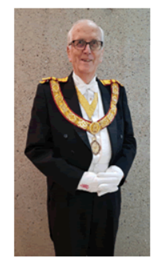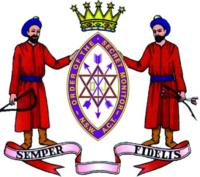The Order of the Secret Monitor
23 August 23
This order is known as ‘The friendly order’ and is open by invitation only. It is a very interesting order of Freemasonry. The bond of brotherhood is based upon obligations of a kind which go further into human nature than any other, either in the Craft or any of the concomitant orders. He who acts upon his Craft obligations will hold out his hand to help his Brother out of the mire, but he who acts upon that of a Secret Monitor will hold out his hand when he sees his Brother about to fall in. The legend narrated during the admission of candidates is the story of the friendship which existed between David and Jonathan.
This friendship was all the more remarkable because King Saul, the father of Jonathan, hated David with almost unequalled intensity, and on more than one occasion sought his life. Meetings of the two friends, therefore, were attended with considerable risk, and it became necessary to devise some form of warning which should convey information to David without necessarily enlightening anyone else.
The Origins of the Order
The whole story can be read in 1 Samuel xx, v.18 et seq.: and in accordance therewith it is the duty of obligation of every Secret Monitor to convey notice of impending danger to his Brother, and even to warn him when he appears to be embarked upon a wrong course of conduct likely to entail disastrous consequences. In saying all this no obligation of secrecy is violated for the ritual is published by authority. The first references to such an association are to be found in a code of rules of government found in Amsterdam in 1770. What the history of the Order was in Holland is not known. Kloss gives the title of a book published in 1778 at Amsterdam which gives its statutes and formulary of reception.
It did not become an effective Masonic tie until the period of the Civil War which devastated the United States of America. Dr I. Zacharie, the first Supreme Ruler of the Order as established in England, had a very adventurous career during the period referred to. In his medical capacity he was constantly in the camps of both parties to the strife, and had frequent opportunities of seeing how Freemasonry could amend the horrors of Civil War, when Brother’s hand was against Brother’s instead of being clasped in it. The degree of Secret Monitor, which had been carried to the New World by Dutch immigrants, appeared to Dr Zacharie to afford the means of cementing a closer fraternal union reference in a somewhat slipshod manner, with no organisation and with no ceremonies. The new member was simply taken ‘aside’ and the several degrees communicated to him.
The Order in England dates from 1887. There are now Jurisdictions of the Order, with numerous Conclaves in many countries throughout the world. Their registers contain many distinguished and illustrious names which are quite sufficient to prove the Order is vested in a Grand Council, which is composed of Grand and Past Grand Officers.
Distinctive Officer of the Order
Among the officers are those called Visiting Deacons. These are officers peculiar to this Order, and there is nothing exactly corresponding in any branch of Freemasonry. What their duties are is well described in the following circular. The principles therein laid down, go far to prove that quality rather than quantity is sought for every extension of the Order. To this circular we have prefixed the introduction to the Constitutions, and after reading both extracts no one will deny that a Brother who is invited to become a Secret Monitor must have formed and lived up to a very high ideal of Freemasonry.
 Most Worthy Brother Oliver Bergstrom 2021-2023
Most Worthy Brother Oliver Bergstrom 2021-2023
‘In as much as the peculiar characteristic of the Order consists of giving friendly monition and warning to its members in time of danger, and in affording support and assistance to them in time of sorrow and distress, it is expressly enjoined on the Visiting Deacons as the chief duty of their office is to search or apparent, and to visit those afflicted with sickness or sorrow, or otherwise in need of fraternal help and consolation. A statement that this duty is specially recognised as a distinguishing feature of the Order shall appear in the by-laws of every Conclave; and the officers of every Conclave shall be a fundamental principle of the Order and be practically carried into effect during their term of office.’
‘The Grand Visitors point out the fundamental principle underlying all the teachings of the Order, with regard to the duties of Conclaves, may be summed up in an affirmative reply to the old question, ‘Am I my brother’s keeper?’ and that the function imposed upon Visiting Deacons at their appointment is that of officers selected to discharge, on behalf of the Conclave, this duty of keeping in constant touch with the rest of the Brethren and of conveying to the Conclave, at its periodical meetings of their welfare, or should providence so will it, their ill-fare.’
The Structure of the Order
The Order of the Secret monitor possesses its own phraseology. Its Lodges are ‘Conclaves’ and usually meet quarterly. Members are ‘inducted’ in the first degree, ‘admitted’ to the second degree and the Supreme Ruler is ‘commissioned.’ Every Brother is placed in the charge of a Visiting Deacon, of which there are four. It is the duty of the Deacon to contact them at intervals between the meetings, and at each meeting to report to the Conclave. Should any trouble befall a Brother, he should apply for help to his Deacon, who is bound to do all he can for him. It is an admirable scheme, but its success depends almost entirely on the conscientiousness of the Deacons.
History and Structure in NSW & ACT
The first Conclave in NSW was the Sydney Conclave, consecrated by RW Bro G.C. Kingscott PGC, District Grand Supreme Ruler of the Southern jurisdiction of Australia, on 23 June 1945. The first autonomous jurisdiction in Australia was that of NSW & ACT formed in 1958 with the first Grand Installation held in 1959. This Grand Council of NSW & ACT celebrated its Golden Jubilee Installation on 10 October 2009 at The Sydney Masonic Centre.
There are currently 30 Conclaves within the jurisdiction, 14 meeting in the metropolitan area, 15 in the country area and one travelling Conclave.
For further general information please access the website www.osm-nsw-act.org


